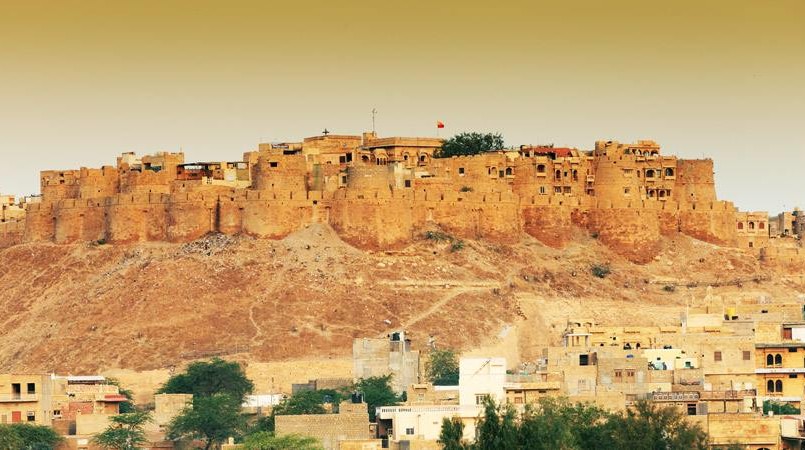Nestled in the heart of Rajasthan’s Thar Desert, Jaisalmer Fort stands as a timeless testament to India’s rich cultural heritage. Known as the “Sonar Quila” or Golden Fort, it rises majestically above the golden sands, captivating visitors with its stunning architecture and historic charm. A Jaisalmer Sightseeing tour often begins here, as this UNESCO World Heritage Site is the crown jewel of the city, reflecting the grandeur of Rajputana craftsmanship.
Constructed in 1156 AD by Rawal Jaisal, the fort is not merely an architectural masterpiece but also a living monument. Unlike most forts in India, Jaisalmer Fort houses a bustling community within its walls, including homes, temples, shops, and restaurants. Its unique blend of history, architecture, and daily life makes it a must-visit destination.
Intricate Carvings and Ornate Gates
One of the most striking features of Jaisalmer Fort is its intricately carved gates. The main entrance, Ganesh Pol, is a marvel of design, showcasing traditional motifs and patterns carved into golden-yellow sandstone. As you pass through Akshya Pol and Hawa Pol, the artistry continues to amaze, with each gate offering a glimpse into the grandeur of Rajput architecture.
The gates were strategically designed to confuse enemies and make the fort impenetrable. The fusion of function and beauty in their design reflects the ingenuity of the architects who envisioned a fortification that was as formidable as it was beautiful.
Raj Mahal: The Royal Abode
Inside the fort lies the Raj Mahal, the former royal residence of the Maharajas of Jaisalmer. The palace is an architectural marvel with its delicate lattice work, expansive courtyards, and intricately painted ceilings. Walking through its corridors offers a peek into the opulent lifestyle of Jaisalmer’s rulers.
The palace’s carved balconies and windows are adorned with traditional motifs, showcasing a seamless blend of aesthetics and functionality. Visitors can also explore its museum, which houses artifacts, manuscripts, and other historical treasures that provide insight into the fort’s regal past.
Jain Temples: Spiritual Sanctuaries
The fort is home to a group of seven stunning Jain temples, renowned for their exquisite architecture and spiritual ambiance. Built between the 12th and 16th centuries, these temples are dedicated to various Jain Tirthankaras. Their intricate stone carvings depict scenes from Jain mythology, celestial beings, and flora, reflecting the artisans’ unparalleled craftsmanship.
Among the most notable temples is the Parsvanath Temple, a masterpiece of craftsmanship with its intricate carvings and beautifully adorned ceilings. A visit to these temples offers not only a spiritual experience but also an appreciation of the artistic excellence of the era.
Merchant Havelis: Echoes of Affluence
Jaisalmer Fort is surrounded by exquisite havelis, which were once the homes of wealthy merchants. These havelis, such as Patwon Ki Haveli, Nathmal Ki Haveli, and Salim Singh Ki Haveli, are architectural wonders with their intricate facades, ornate windows, and elaborate balconies.
Patwon Ki Haveli, in particular, stands out as a cluster of five havelis adorned with golden sandstone carvings. The minute details in the latticed windows and archways are a visual delight, making these structures a highlight for anyone exploring Jaisalmer’s rich architectural heritage.
Strategic Engineering: A Fortified Wonder
Jaisalmer Fort’s strategic design is a marvel of ancient engineering. Perched on Trikuta Hill, it offers panoramic views of the surrounding desert, ensuring visibility of approaching enemies. Its massive sandstone walls, reinforced with bastions and battlements, glow in golden hues under the sun, blending harmoniously with the desert landscape.
The fort’s drainage system, known as “Ghuta Prol,” showcases advanced engineering. It ensured effective water management, preventing damage to the fort’s foundations—a necessity in the arid desert environment. This ingenuity demonstrates the foresight of its builders.
The Living Fort: A Unique Experience
What sets Jaisalmer Fort apart is its status as a “living fort.” Approximately a quarter of Jaisalmer’s population resides within its walls, adding a unique charm to this historic site. Narrow winding lanes are lined with shops selling local handicrafts, cafes offering traditional Rajasthani cuisine, and homes that have stood for centuries.
This living heritage creates an immersive experience for visitors, offering a blend of history and modernity. Exploring the vibrant bazaars within the fort is a treat, with opportunities to purchase handcrafted textiles, jewelry, and souvenirs that reflect the culture of Rajasthan.
Best Way to Explore Jaisalmer Fort
To truly appreciate the magnificence of Jaisalmer Fort and its surroundings, it’s essential to have reliable transportation. Opting for a Taxi service in Jaisalmer ensures a hassle-free experience, allowing you to explore the fort and other attractions in the city comfortably. Knowledgeable local drivers often share fascinating anecdotes, enriching your journey through this historic marvel.
Conclusion
Jaisalmer Fort is a treasure trove of history, architecture, and culture. Its intricate carvings, strategic design, and vibrant community make it a destination like no other. From the royal Raj Mahal to the spiritual Jain temples, every corner of the fort tells a story of the bygone era. A visit to this architectural marvel is not just a journey into history but also an experience of Rajasthan’s timeless beauty and charm.
Plan your visit to Jaisalmer Fort to witness firsthand the brilliance of Rajputana architecture and immerse yourself in the vibrant culture that thrives within its golden walls.

